|
NATIONAL PARK SERVICE
Park Structures and Facilities |

|
CAMPFIRE CIRCLES and AMPHITHEATERS
THESE POINTS of open air assembly and seating in parks range from the minor, represented by the campfire circle, sometimes termed a lecture circle or council ring, to the large and elaborate in the form of outdoor theater or amphitheater. The elementary expressions are to be found in many parks, while the more extensive developments are apt to occur in large parks appealing to more than local interest, or in metropolitan parks where local or civic interest is well defined. The locating of the intimate circle or ring is largely a matter of proximity to use-demand, as represented by a cabin or camp group, or other such point of concentration within the park. A small plot preferably generally level, but failing that, not too rugged or precipitous, is the only topographic requirement. The larger amphitheater, in its several varying manifestations, should on the other hand be located in a natural bowl wherever possible. Unless existing contours truly invite such development, a remoulding of them to create a natural effect is apt to require an amount of work disproportionate to the gain. If anything short of accomplishment of complete naturalness results from a remoulding of topography in creation of an amphitheater, the park area is burdened with a disfiguring scar that should be rigidly avoided.
The minor campfire circle or ring is merely the provision of seating around the community campfire, where the evening hours may be passed with song and story in the warmth of good comradeship and the friendly fire. The campfire is the sole physical essential of this foregathering place in the open. It is often given a fixity of location by the building of seats around it, particularly if conditions of climate or insect life make sitting on the ground unadvisable. Such seating may be merely logs or some more sophisticated adaptation of them, or again may be boulders or masonry construction, where stone is the more abundant native material. But there are no fixed principles, no traditions to be pressed, beyond admonishing an attention to the claims of the immediate natural environment.
The principles applicable to the creation of amphitheaters or outdoor theaters are numerous. Probably paramount are the considerations of sight lines and acoustics, here quite as important as for the enclosed auditorium. Many will at first thought regard acoustics as not of the problem, but these should not fail to appreciate that hills and mountains, water surfaces, woods and forests, deflect and echo sound in accordance with their own laws, no less than do man-made surroundings, and call for just as much study and advance consideration.
It is important that the stage be to the east or north, so that the audience will not face the afternoon sun. A distant view as background for the stage platform is greatly to be desired, or better still a picturesque cliff as at Pine Mountain, in Kentucky. If these do not exist, a background of trees should be sought. The amphitheater should be encircled by trees, to screen it from view and provide all possible shade for the audience, and to act as barrier against the disturbing noises of other park activities.
The outdoor stage is often merely a platform, the distant view or a near-by stand of trees serving as a backdrop. If these are lacking, or some required use of the stage demands it, an artificial background of rustic construction, or of planting, or a combination of the two is created. When the showing of motion pictures is an activity, the extent of the structural background will be dictated by the size of the picture screen. The screen should be removable in winter, should be recessed for some measure of protection, and supplemented with dark canvas curtains to be drawn over it when pictures are not being shown. Where dramatic entertainment is to be offered, some provision of dressing room space is necessary. The stage of the amphitheater, being the focal point, must be outstandingly representative of park character. No harshness or rigidity of line is to be tolerated here and all the devices of skillful planting and naturalizing of native rock are legitimate in creation of the desired effect.
The seating of the amphitheater in a park setting is contrived of logs or of stone. It may be said of log seating that it is the more comfortable in use, but the adjusting of the long straight lengths to the segmental arrangement of seats results in angles that are rigid and in a measure inharmonious with the freehand lines of nature. Although stone seating on the other hand offers less physical comfort, it permits flowing and graceful curves in the seating arrangement that please the eye and complement the surroundings.
The cutting of large trees existent within the limits of the seating of the amphitheater is to be avoided. It is better to interrupt the seating to accommodate the trees. The latter, if trimmed of the lower branches, will provide shade for the audience with negligible obstruction to view of the stage.
Usually a campfire is built in front of the stage platform, or to one or both sides of it. Sometimes this must serve to illuminate the stage at night, in lieu of footlights or other lighting. Whether or not it must serve such purpose it links the pretentious amphitheater with the simple campfire ring from which it evolved and is the temporary home fire of the wanderer.

|
|
CAMPFIRE CIRCLE—SPRAGUE CREEK CAMPGROUND
Here is simple provision of seating
around a campfire that is devoid of all formality. The plan has been
judiciously accommodated to existing trees and topography. The seating
capacity is approximately three hundred people.
GLACIER NATIONAL PARK |
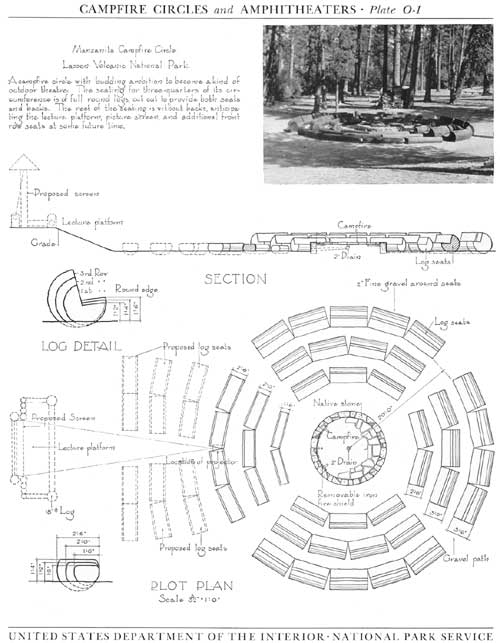
|
| Plate O-1 (click on image for a PDF version) |
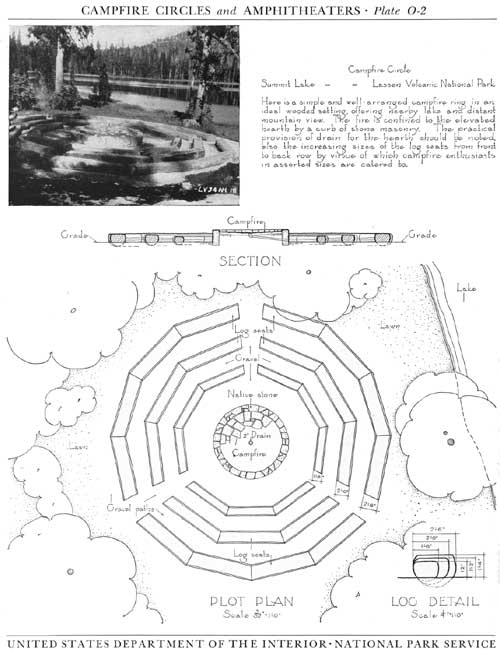
|
| Plate O-2 (click on image for a PDF version) |
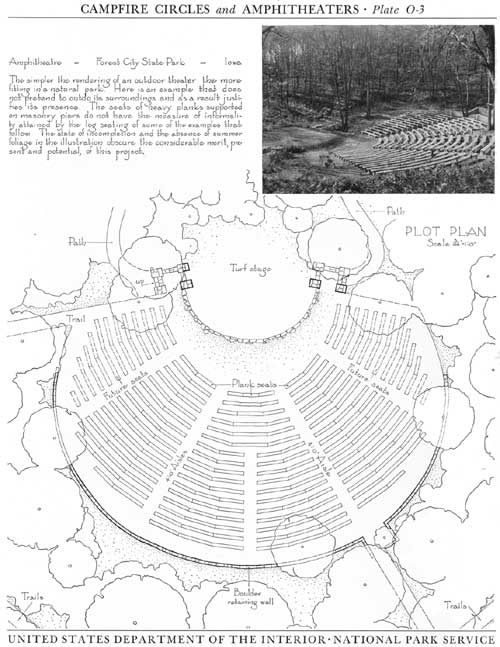
|
| Plate O-3 (click on image for a PDF version) |
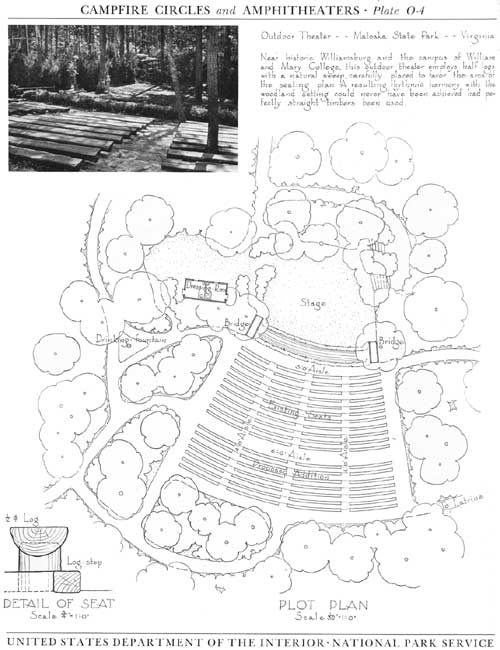
|
| Plate O-4 (click on image for a PDF version) |
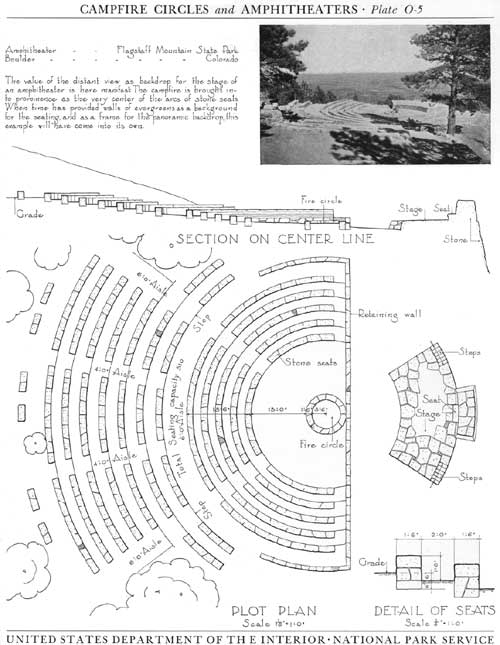
|
| Plate O-5 (click on image for a PDF version) |
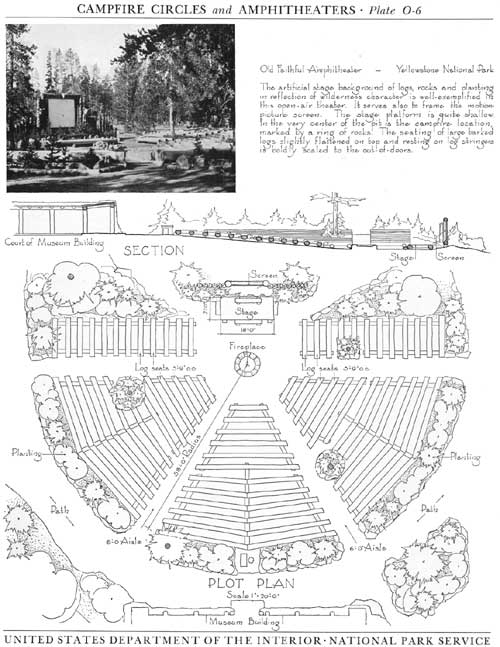
|
| Plate O-6 (click on image for a PDF version) |
| <<< Previous | <<< Contents>>> | Next >>> |
park_structures_facilities/seco.htm
Last Updated: 5-Dec-2011